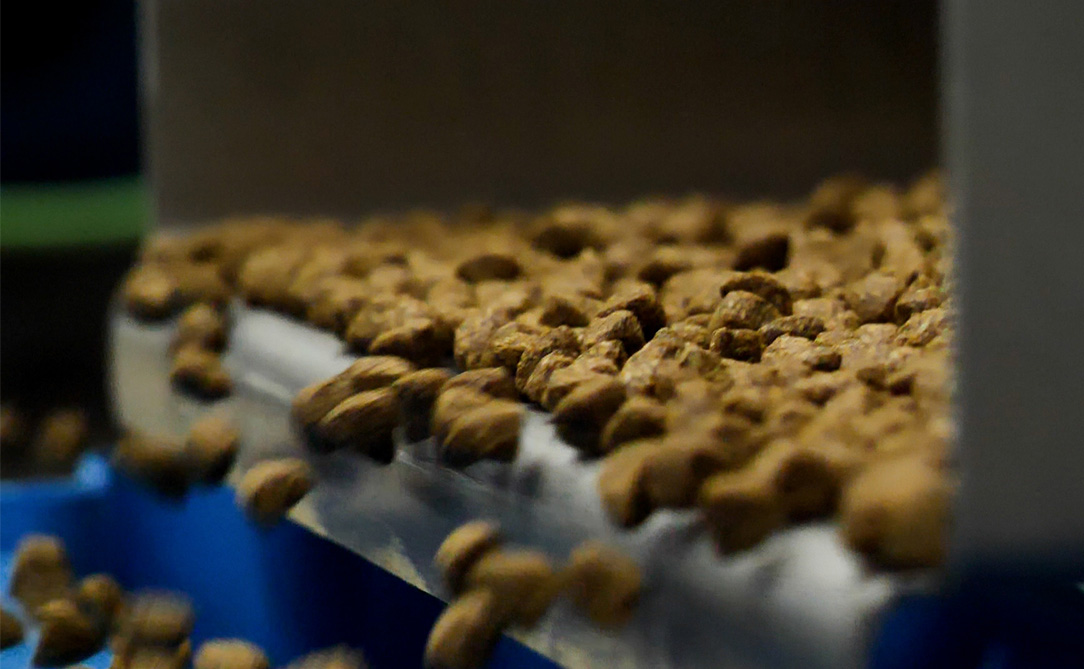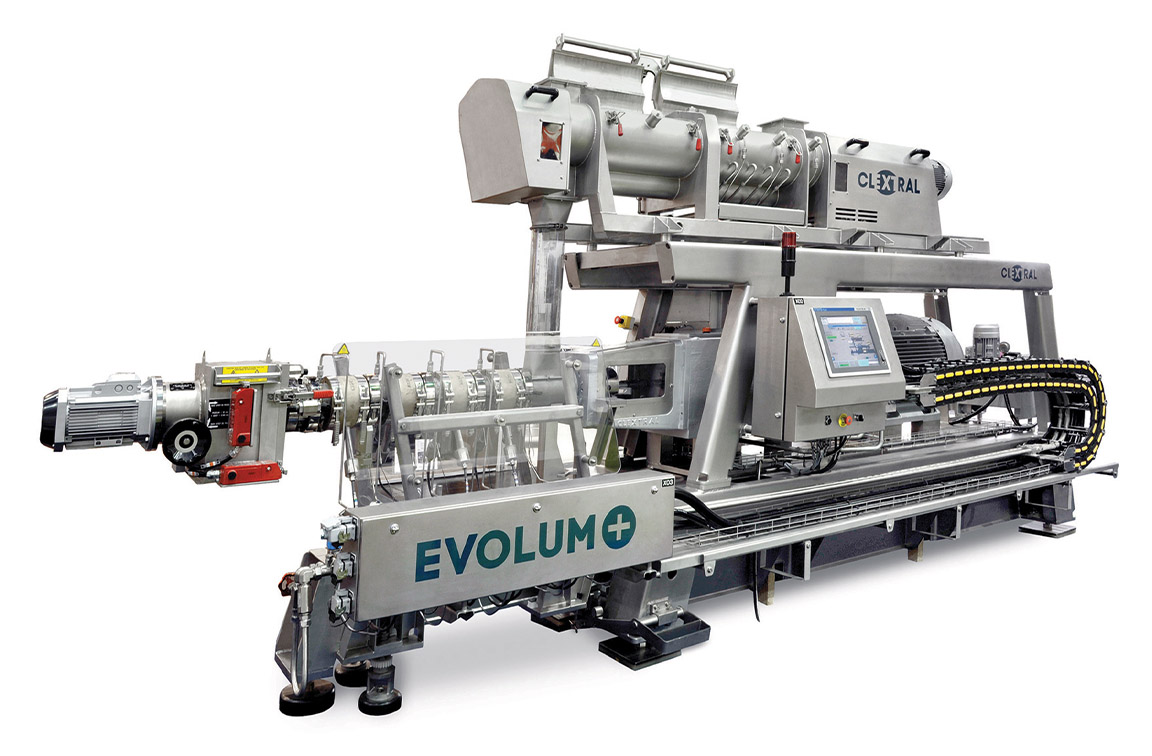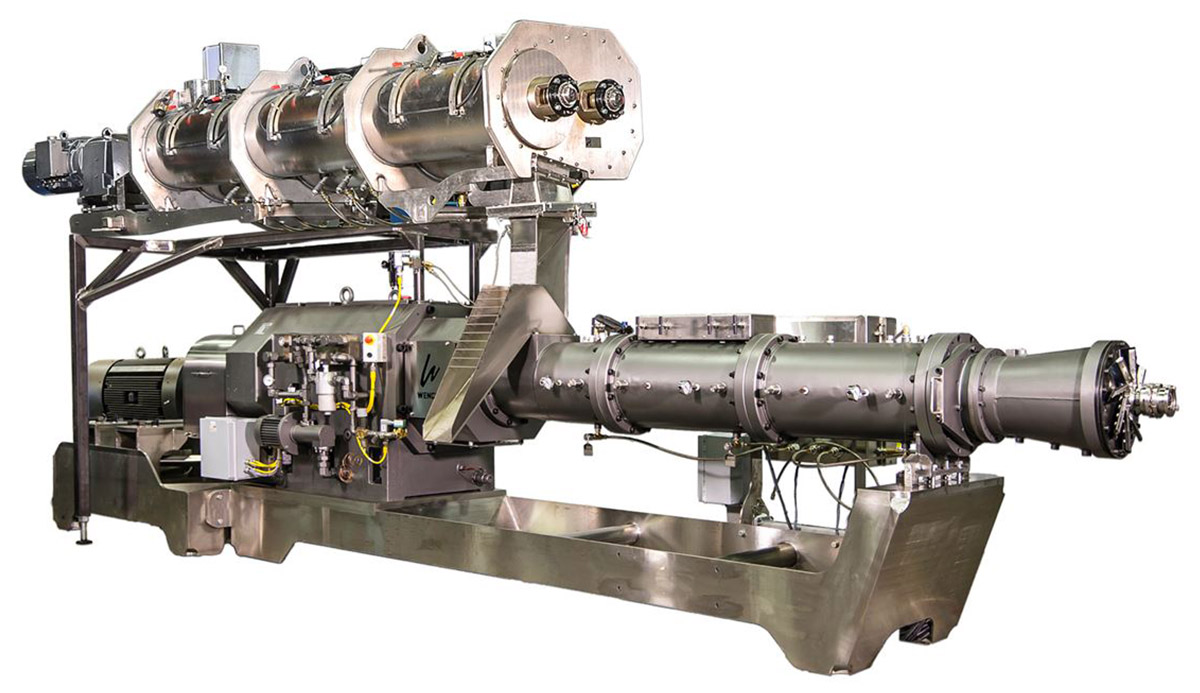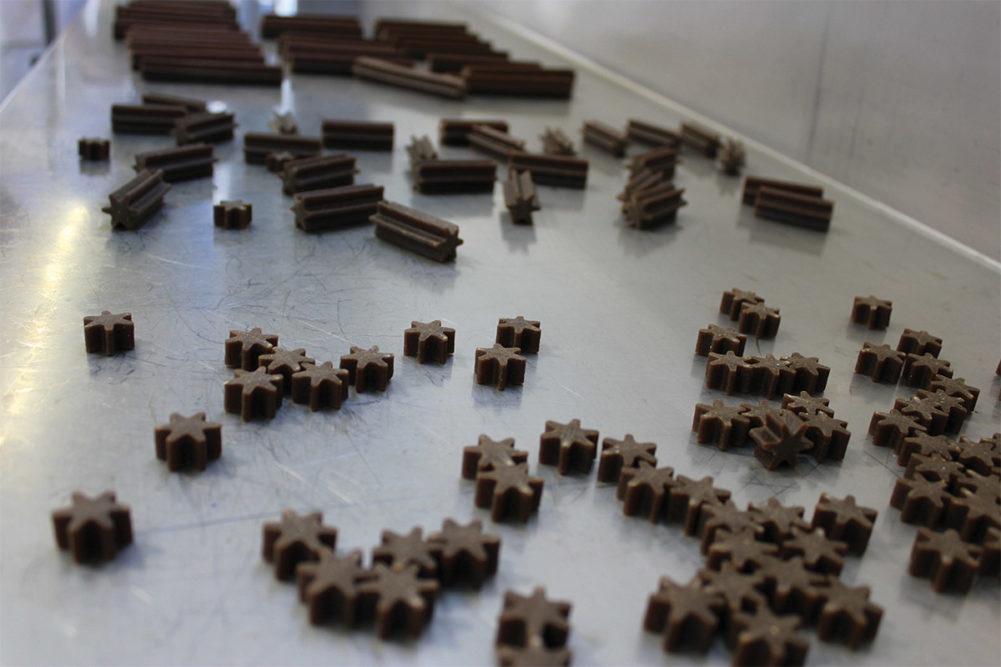This article was published in the May 2023 issue of Pet Food Processing. Read it and other articles from this issue in our May digital edition.
In the ever-evolving world of pet food manufacturing, extrusion technology continues to play a crucial role in ensuring the efficient and effective production of high-quality pet food products. This versatile technology has advanced over the years, allowing pet food producers to further capitalize on its capabilities and benefits.
Key benefits
Extrusion technology offers a more efficient and cost-effective method for pet food production in comparison to labor-intensive processes like batch cooking. By utilizing a continuous process, extrusion significantly reduces the time, labor and energy required for pet food manufacturing. In addition, the flexibility of extrusion technology allows processors to produce various shapes, sizes and textures of pet food products.
“The continuous extrusion process is highly efficient in its utilization of raw materials and energy,” explained Sylvie Brunel, Ph.D., process and innovation director, Clextral Inc, Tampa, Fla. “Extrusion provides consistent product quality, and the extruder offers a great degree of process flexibility. Multiple products can be processed on one extruder by varying the ingredients, screw profiles and process parameters. Multiple shapes and sizes are also possible with simple die changes.”

Extruders provide pet food and treat processors with a range of process flexibility in the sizes, shapes and styles of products that can be produced.
|Another major advantage of extrusion technology is its ability to provide a food-safe cooking method with an industry-standard Critical Control Point (CCP) for product temperature. This ensures that the final product is not only of high quality but also safe for pet consumption.
“All pet food producers are faced with the challenge of food safety for their products and processes. More specifically, integrating a CCP in their processes,” said Keith Erdley, process technologist, Wenger, Sabetha, Kan. “A CCP is required for all [human] food, pet food and pet treat processes. Extrusion provides a food-safe cooking method that provides an industry-standard CCP of product temperature. If products are not extruded, the CCP becomes a bit more difficult, as CCPs in ovens and dryers are not as black and white and have presented challenges in validating that all product meets the CCP requirements.”
Brunel added, “The extruder ensures food safety as the high-temperature process is an effective ‘kill step’ for many common pathogens including Salmonella and E. coli.”
This further enhances the safety and quality of the final product, ensuring the health and wellbeing of pets are not compromised.

Efficient extrusion equipment can help pet food and treat processors produce a wide range of product styles on the same machine.
|Selecting the right extruder
When selecting extrusion equipment, pet food and treat processors must consider a number of factors, including flexibility, cost, sanitation and process support. By balancing these factors, processors can select the right technology to meet their production goals.
“A common ‘ask’ from our clients over the last several years has been flexibility to produce a wide range of products with diverse ingredients using the same equipment,” Erdley said. “In our clients’ eyes, the humanization happening in the pet food industry demands this flexibility to allow for modifying recipes with all types of ingredients (fresh or dry) and even processing different shapes and sizes in both kibbles and treats.”
“The equipment architecture should be designed with flexibility and expansion considerations to facilitate ever-changing market trends,” added Will Henry, director of technology and R&D, Extru-Tech, Sabetha, Kan.
This allows processors to easily change their production processes, meet changing consumer demands, and ensure they maintain a competitive edge.
When it comes to cost, choosing between single-screw and twin-screw extruders is an important decision. While both types of extruders offer their own advantages, twin-screw extruders may be the better choice for producing premium pet foods and treats. Additionally, twin-screw extruders can process a greater range of ingredients and recipes, making them an attractive choice for pet food processors looking to diversify their product lines.
“Single-screw extruders are typically less costly than twin-screw extruders,” Brunel explained. “While single-screw are the accepted standard for kibble production, if you are looking to produce premium kibbles, HME or treats, twin-screw extrusion will generally process better product and the cost differential will be well spent.”
While twin-screw extruders have their distinct advantages, single-screw extruders have proven to be reliable and versatile in many pet food processing applications. They are capable of handling a wide range of ingredients and can produce various shapes and sizes of kibbles, making them a valuable choice for many pet food processors.
“If we have learned one thing it is that the single-screw extruder has been drastically under-valued in terms of flexibility,” Henry said. “The range of products that are within the single-screw capability has exceeded the expectations of even the most staunch proponent.”
Efficient changeover and sanitation are also essential considerations when selecting the right extrusion equipment. By choosing extruders and preconditioners designed for quick cleanout, processors can save valuable time and resources.
“Clextral extruders offer hydraulic barrel opening that allows immediate screw and barrel access for cleaning and screw profile reconfiguration,” Brunel said. “Our preconditioners are designed for quick cleanout; in discharge mode, the reversible AFC device allows the entire line to be emptied in under two minutes.”
Finally, it’s important to select an extrusion equipment manufacturer that offers comprehensive process support. This includes assistance with product development and testing, troubleshooting process issues, and providing technical advice.
“Extrusion equipment selection should focus on an OEM that provides the widest range of process flexibility from a single architecture to facilitate the aggressive and diverse formula challenges,” said Will Henry, Extru-Tech.
“Extrusion equipment selection should focus on an OEM that provides the widest range of process flexibility from a single architecture to facilitate the aggressive and diverse formula challenges,” Henry said. “Service is paramount, both in terms of equipment support and product development. Our clients continually broadcast their accolades toward our industry-leading service technicians and their attention to detail and specific client needs.”
Overcoming challenges
Pet food processors are constantly striving to innovate and improve their product offerings, but this pursuit of excellence is not without its challenges. As processors work to develop new recipes and formulations, they must contend with various obstacles related to ingredients, commodity market fluctuations and the extrusion process itself.
“Extrusion technology offers the most flexible cooking system for inclusions of almost any ingredients that can be dreamed up. But new ingredients in recipe formulations can sometimes bring challenges,” Erdley said. “In most cases, the issue is due to a misunderstanding of the extrusion characteristics of ingredients. The solution is understanding the formula ratios necessary to have a complete nutritious diet and keep the desired key ingredients at or near the top of the ingredient list on the package.”

Clextral’s EVOLUM+ extruders deliver up to 40% higher production volume than its standard models.
|One of the major roles of extrusion equipment manufacturers like Wenger is to assist customers in creating new products that are easy to produce. This includes conducting research, providing guidance on ingredient selection, and offering solutions for process optimization.
“The number of new ingredients in the pet food creation list is always growing, and this pushes formulators to develop recipes that will extrude correctly,” Erdley added. “The key is to conduct research and testing to understand each new ingredient’s extrusion characteristics. This is a big part of how Wenger helps customers develop new products that can be produced effectively.”
Ingredient shortages and commodity market fluctuations can also have an impact on the extrusion process. This is especially true for processors handling premium products as these tend to require more expensive ingredients that are sensitive to price changes.
“The ever-fluctuating commodity market has forced the manufacturing industry to compensate for least-cost formulators, ingredient vendor changes, and atypical protein sourcing,” Henry said.
This reiterates the need for processors to partner with an extrusion equipment manufacturer that has the experience and knowledge to help them optimize their process, no matter what type of product they are producing.
The future of extrusion
In recent years, extrusion technology in the pet food industry has evolved toward energy efficiency and sustainability. In particular, thermal energy systems are gaining interest due to their renewable and energy-efficient characteristics.

Wenger’s twin-screw Magnum extruder allows processors to maximize output in a smaller footprint.
|“Energy efficiency and sustainability of the process has been the greatest advancement in extrusion technology in recent years — and this is still evolving,” Erdley said. “Thermal energy (steam or surface heating) has piqued interest, as these systems can be electric (which is renewable) or even extremely energy efficient with closed loop surface heating systems (for extruder barrel elements). With the recent findings on improved palatability of foods created when cooking with thermal energy rather than mechanical energy, this fits well with the sustainable demand.”
Looking to the future, pet food processors can expect to see further innovations in extrusion technology that will help them produce cost-effective and high-quality products for their customers. With the help of an experienced partner, they can optimize their processes and explore opportunities to develop exciting new products that will meet customer needs.
“With the proliferation of new products for all life stages of pets, there are many opportunities for pet food processors to expand their product lines,” Brunel said. “Pet parents are looking for new foods including super premium foods with fresh meat, foods with more vegetable proteins and limited ingredients. Processors seeking new product development can take advantage of Clextral’s ongoing R&D to access our high-level expertise in new recipe development and optimization of process parameters for enticing taste and texture.”
“Energy efficiency and sustainability of the process has been the greatest advancement in extrusion technology in recent years — and this is still evolving,” said Keith Erdley, Wenger.
Another key trend that is set to continue is the use of fresh inclusions such as meats, vegetable and insect proteins, fruits and vegetables. These inclusions offer sustainable and energy-efficient solutions, supported by advancements in thermal and lower mechanical cooking. Finally, extrusion technology enables global use of local ingredients, reduced waste, and ongoing research and development.
“Extrusion offers the flexibility for processors to utilize local ingredients no matter their location around the world, and the extruder’s capability to quickly adjust process parameters to operating conditions reduces product waste,” Brunel said. “The research and development carried on by extrusion equipment manufacturers and ingredient suppliers will continue to push the boundaries of pet food nutrition and quality. Processors can take advantage of this expertise in creating new products that support animal health and wellness.”
Find more articles about the latest pet food processing technologies on our Equipment page.





